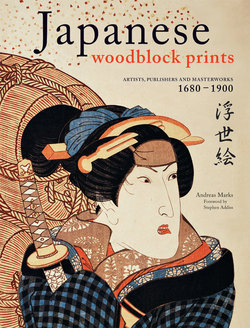Читать книгу Japanese Woodblock Prints - Andreas Marks - Страница 28
На сайте Литреса книга снята с продажи.
ОглавлениеToyoharu
1735–1814
Family name: Tajimaya. Given names: Shōjirō, Shin’emon, Masaki. Art surname: Utagawa. Art names: Ichiryūsai, Sen’ō, Senryūsai, Shōjirō.
Toyoharu, born 1735, was from Toyooka in Tajima Province, Western Japan. He went to Kyoto and first studied painting under the Kanō School master Tsuruzawa Tangei (1688–1769). According to the Utagawa retsuden (Lives of Utagawa school masters) he moved around 1763 to Edo and became a student of the print artist Toriyama Sekien (1712–1788). The “Toyo” in Toyoharu’s studio name is apparently derived from Sekien’s personal name Toyofusa. Toyoharu was also influenced by Ishikawa Toyonobu (1711–1785) and Suzuki Harunobu.
Because he lived in Udagawachō in Edo’s Shiba district, he started to use the name Utagawa and, as things developed, he became the founder of the Utagawa school with Toyokuni and Toyohiro as his main students. Toyoharu had a strong influence on successive generations of print artists but was also the teacher of painters such as Sakai Hōitsu (1761–1828), who created a distinctive Rinpa style in Edo.
Active from around 1768, he is especially important for his horizontal prints using the Western technique of one-point vanishing perspective. These perspective prints illustrate famous Japanese sights, temples, theatres, and teahouses, as well as Occidental scenes from history and legend. Also produced in series, predominantely for the publisher Nishimuraya Yohachi, these series usually have the phrase “uki-e” (perspective pictures) in their title. Next to horizontal prints, Toyoharu did also several “pillar prints” (hashira-e).
After working for less than ten different publishers during his entire career, he seemed to have stopped designing prints in the 1780s and turned to paintings. After 1785, he also designed a few kabuki programs and billboards. In 1796, he was appointed head of painters working on the restoration of the Tokugawa shrine in Nikko. Contrary to his students, he was not active in illustrating books apart from two publications, one being “Illustrated Book of Edo Brocade” (Ehon Edo nishiki) from 1804.
He died aged 80 and his posthumous Buddhist name is Utagawain Toyoharu Nichiyō Shinji. He is buried at the Nichiren Temple Honkyōji, located in present-day Ikebukuro.
early 1770s An imaginary depiction of the letter reading scene from the “Treasury of Loyal Retainers” (Chūshingura). Hashira-e. Library of Congress. Pins 1982, fig. 916.
early 1770s "View of the night show at the opening-of-the-season performance at Fukiyachō and Sakaichō” (Sakaichō Fukiyachō kaomise yoshibai no zu), from the series “Perspective Images” (Uki-e). ōban. Publisher: Nishimuraya Yohachi. Library of Congress.
1770s “View of group amusement at the New-Yoshiwara” (Shin-Yoshiwara sō jimai no zu), from the series “Perspective Images” (Uki-e). ōban. Publisher: Matsumura Yahei. Library of Congress.
early 1770s “Daidai kagura performance at the two sites of Ise Shrine”(Isedaijingūr yōsho daidaimikagura no zu), from the series “Perspective Images” (Uki-e). ōban. Publisher: Nishimuraya Yohachi. Library of Congress.
1770s “View of Shiba Shinmei Shrine” (Shiba shinmeigū no zu), from the series “New edition of Perspective Prints” (Shinpan uki-e). ōban. Publisher: Nishimuraya Yohachi. Library of Congress.
early 1770s “View of the Hall of Thirty-three Bays at Fukagawa in Edo” (On-Edo Fukagawa Sanjūsangendō no zu), from the series “Perspective Images” (Uki-e). ōban. Publisher: Nishimuraya Yohachi. Library of Congress.
1770s “Morning Fuji at Tago Bay” (Tago-no-ura haru no Fuji), from the series “New edition of Perspective Prints” (Shinpan uki-e). ōban. Publisher: Izumiya Ichibei. Asian Art Museum, National Museums in Berlin.
